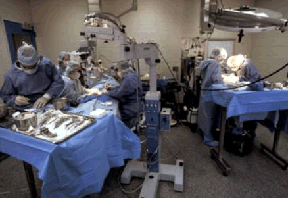
The transplant team sets up. Photo courtesy of Dr. Lillian Aronson
Kidney transplants are something everyone has heard of for people, but may not have considered possible for pets. In fact, while transplants are confined to specialized facilities with experienced surgeons, successful kidney transplants in cats have been going on since the mid-1980s. Canine programs have been less successful but are also available in limited facilities.
To the uninitiated, the impression may be that once someone receives a new kidney, life is renewed and all the kidney problems are solved. In fact, this is hardly the case. There are immune-suppressive medications needed to prevent the new organ from being rejected, not to mention potential for infection, on-going screening tests, and other issues. A kidney transplant is a very big deal regardless of the species, and not every patient is even a candidate, so let's walk through the main considerations.
Where Do the Donors Come from and what Happens to them Afterwards?
This question is important ethically for everyone involved in the transplantation program. No one wishes to harm the donor animal who cannot voluntarily become an organ donor in the way a human can, nor is there a mechanism to harvest organs from comatose brain-damaged patients as might be done for humans.
Feline kidney donors usually come from research facilities. These cats are classified as “specific pathogen free,” which means they are free from infectious diseases. They are matched by blood typing and potentially by tissue-typing depending on the transplant program. A research cat is selected and a kidney removed for the recipient. After the procedure, the owner of the recipient cat must adopt the donor.
Some transplantation programs allow the owner of the recipient cat to provide the donor. Donors must be young adults, generally at least 10 pounds in size, be free of infectious diseases such as feline immunodeficiency virus, feline leukemia virus, and toxoplasmosis, and must have excellent kidney function. Basic blood testing and urine cultures must be normal.
Kidney transplant donor and recipient cats

Ollie and Mr. Moto now live together after one cat's kidney was transplanted into the other. Photo courtesy of Dr. Lillian Aronson.
You enter the program with one cat and leave with two cats.
For dogs, the owner of the recipient is generally responsible for finding the donor. The University of California transplant program has been on hold since 2007, but as an example, their former donor guidelines were that the donor must be less than 6 years of age, of similar size as the recipient (and preferably of the same breed), and, if the donor is not related to the recipient, tissue matching is needed.
Is your Cat a Candidate?
Kidney transplantation is not a procedure that is left until all medical therapies have been exhausted. The best candidate is free from other medical problems besides the kidney disease. Typical screening includes:
- Basic blood panel (including thyroid level) and urinalysis
- Urine culture (elimination of latent infection is crucial and often a trial of immune-suppressive drugs is used after an infection has been cleared to ensure that the infection does not come back)
- Feline leukemia virus and feline immunodeficiency virus screening
- Ultrasound examination of the heart (heart diseases that involve high blood pressure development can damage the new kidney)
- Screening for toxoplasmosis (the immune suppressive drugs needed to maintain the new kidney could reactivate a latent infection with this parasite). A positive test for Toxoplasma does not preclude the transplant but a positive donor must be selected. Recipient cats testing positive for Toxoplasma are generally kept on clindamycin for life. Recipient cats testing negative will be periodically screened for Toxoplasma for the rest of their lives.
- Blood typing
- Blood pressure monitoring
- Urine protein to creatinine ratio to evaluate glomerular disease/renal protein loss.
- Teeth cleaning (performed under anesthesia)
Different programs may have additional required screening tests such as kidney biopsy, intestinal biopsy to rule out inflammatory bowel disease, test doses of immune-suppressive medications, etc. Obviously the details would be provided by the specific program being considered.
If the cause of the kidney failure is felt to be something that would lead the new kidney to fail as well, this may disqualify the patient from the program. Such conditions would include: renal lymphoma or other cancer, amyloidosis (a malignant protein deposition), and pyelonephritis (a deep kidney infection, although if the infection is truly felt to have been eliminated, the patient might still qualify). Again, each program will indicate what conditions might serve to automatically disqualify a recipient.
An additional problem for dogs worth mentioning is intestinal intussusception. Imagine a telescope. Unfolded, it is basically a cylinder but folded, one segment collapses inside an outer segment. Now imagine this happening to a piece of intestine. A life-threatening obstruction results. A procedure called enteroplication is given in conjunction with the transplant. In this procedure, the intestines are tacked down with sutures into a formation that precludes any telescoping motions. This procedure, along with proper pain medication post-surgically, seems to prevent intussusception.
Cats with relatively early kidney failure are not yet candidates for transplantation. Cats with advanced kidney failure are not good candidates either, although dialysis (available at advanced critical care facilities such as those that perform kidney transplants) may improve the values.
The best candidates are those with an acute cause of kidney failure (such as a poisoning), cats who do not respond well to the usual medical management, or cats with a creatinine greater than 4.0 mg/dl. The cat should have a decent appetite and be as strong as possible prior to this major surgery. Again, each transplant center will have its own criteria.
Prior to surgery, the recipient cat should be made as stable as possible. Usually a blood transfusion is needed to correct the renal failure-associated anemia. Sometimes dialysis is also needed.
Is your Dog a Candidate?
Recipient screening is similar to that for the feline patient though heartworm testing is needed. Blood clotting tests are also needed for dogs. Similar conditions will also rule a patient out as a candidate (no cancer, heart disease, amyloidosis, or inflammatory bowel disease.) The adrenal hormone excess known as Cushing's disease also precludes getting a kidney transplant. Kidney transplants for dogs are generally not as successful as for cats, so be sure you understand what you are getting into and the likelihood of obtaining the outcome you are hoping for.
What Kind of Home Care Will the Recipient Require?
The recipient is going to require suppression of his immune system for the rest of his life. This not only requires a substantial financial commitment for the medication but also the ability to give the cat oral medication at least twice a day for the rest of his life. The heart of this therapy is a medication called cyclosporine, a medication that has revolutionized organ transplantation for humans. Prednisolone, a commonly used cortisone derivative, is typically used as well, at least to start.
Cyclosporine is typically given twice a day with the lowest blood level of the day being approximately 500 ng/ml around the time of surgery and lowering to 250 ng/ml after a month or so of recovery after surgery. (Rejection of the new kidney occurs when levels dip below 200 ng/ml.)
Cyclosporine has some disadvantages that include:
- Expense
Cyclosporine is expensive. Concurrent administration of ketaconazole, a medication normally used to treat fungal infection, has an added benefit of “potentiating” cyclosporine. This means that less cyclosporine is needed to achieve the desired effect. As long as ketoconazole is well tolerated, a substantial financial savings can be realized. Additionally, if ketoconazole is used, it may become possible to dose the patient only once a day rather than twice. Approximately 30% of transplant patients will not be able to utilize this protocol due to the development of excessive cyclosporine levels or liver enzyme elevations from the ketoconazole.
- Expenses for Monitoring
Periodic blood level monitoring is needed to check that the right dosage is being used. For most drugs, "what you swallow is what your body gets." For other drugs, there are individual variations in how the medication is absorbed, and cyclosporine is one. When two patients take the same amount of cyclosporine, they may not achieve the same serum levels; some individual fine-tuning is needed.
- Long-term use of cyclosporine increases the risk for the development of cancer, specifically lymphoma. At the University of Wisconsin Renal Transplant Center, a 14% incidence of malignant tumor development is reported for cats with post-transplant time (and thus cyclosporine use time) of greater than one year.
In dogs, the chemotherapy agent azathioprine is also regularly used for its immuno-suppressive properties. It’s usually given every other day long term. Medication costs for dogs can vary from $150 per month to $2000 per month depending on the dog’s size.
What are Potential Complications to the Recipient?
There are basically three main complications:
-
Infection from the immune-suppressive therapy is the second most common cause of transplant-associated death (rejection being the first). In cats, Toxoplasma infection is of particular concern and, while preoperative testing may have already been negative, some cats turn positive after the immune suppression begins. Also in cats, old viral upper respiratory infections can be expected to recur and they can be severe. In dogs, life-threatening infections can emerge in any organ system.
-
Stricture (narrow scarring) of the ureter, which is the tiny tube that carries urine from the new kidney to the urinary bladder. If this occurs, another surgery is needed to trim the scarred area and re-attach the ureter to the urinary bladder. The original kidneys are generally not removed unless there is a reason to do so. The new kidney is simply an extra one. There is an approximately 21% incidence of this complication in the first 62 days post-operatively in cats. Mostly males are affected.
-
The risk for the developing diabetes mellitus increases by approximately five times after a kidney transplant.
What Kind of Survival Time can you Expect?
In a recent study of feline kidney transplants, 59% of renal transplant patients were still alive 6 months after surgery and 41% were still alive 3 years afterwards. Apparently the first 6 months is a somewhat crucial time in determining long-term survival.
The University of Wisconsin Renal Transplant Center reports 70% survival at 6 months for cats and 50% survival at 3 years. Of the cats that survived to be discharged from the hospital (i.e. they did not succumb to problems directly related to the surgery), 96% survived to 6 months.
In dogs, the picture is not nearly as bright. The University of California at Davis program was seeing about a 40% success rate.
Kidney transplantation is an expensive undertaking. The University of California at Davis program, for example, required a deposit of $11,000 for cats and $13,000 for dogs. Transplantation involves the adoption of a donor and long-term medication and blood testing for the recipient. If this is something you are seriously considering, be sure to discuss the procedure with the transplant center closest to you as well as with your regular veterinarian.
This article reviews some of the information above but also includes a list of kidney transplant programs around the country.